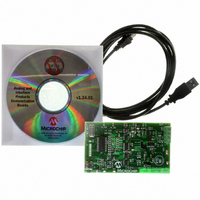TMPSNS-RTD1 Microchip Technology, TMPSNS-RTD1 Datasheet - Page 118

TMPSNS-RTD1
Manufacturer Part Number
TMPSNS-RTD1
Description
BOARD EVAL PT100 RTD TEMP SENSOR
Manufacturer
Microchip Technology
Datasheets
1.MCP3301-CIMS.pdf
(32 pages)
2.PCM18XR1.pdf
(438 pages)
3.MCP6S22DM-PICTL.pdf
(43 pages)
4.TMPSNS-RTD1.pdf
(26 pages)
Specifications of TMPSNS-RTD1
Sensor Type
Temperature
Interface
USB
Embedded
Yes, MCU, 8-Bit
Utilized Ic / Part
MCP3301, MCP6S26, PIC18F2550
Processor To Be Evaluated
MCP6S26, MCP3301, MCP6024, MCP41010, PIC18F2550, TC1071, MCP6002
Data Bus Width
12 bit
Interface Type
USB
Lead Free Status / RoHS Status
Not applicable / Not applicable
Voltage - Supply
-
Sensitivity
-
Sensing Range
-
Lead Free Status / RoHS Status
Lead free / RoHS Compliant, Not applicable / Not applicable
- MCP3301-CIMS PDF datasheet
- PCM18XR1 PDF datasheet #2
- MCP6S22DM-PICTL PDF datasheet #3
- TMPSNS-RTD1 PDF datasheet #4
- Current page: 118 of 438
- Download datasheet (7Mb)
PIC18F2455/2550/4455/4550
10.2
PORTB is an 8-bit wide, bidirectional port. The corre-
sponding Data Direction register is TRISB. Setting a
TRISB bit (= 1) will make the corresponding PORTB
pin an input (i.e., put the corresponding output driver in
a high-impedance mode). Clearing a TRISB bit (= 0)
will make the corresponding PORTB pin an output (i.e.,
put the contents of the output latch on the selected pin).
The Data Latch register (LATB) is also memory
mapped. Read-modify-write operations on the LATB
register read and write the latched output value for
PORTB.
Each of the PORTB pins has a weak internal pull-up. A
single control bit can turn on all the pull-ups. This is
performed by clearing bit, RBPU (INTCON2<7>). The
weak pull-up is automatically turned off when the port
pin is configured as an output. The pull-ups are
disabled on a Power-on Reset.
Four of the PORTB pins (RB7:RB4) have an interrupt-
on-change feature. Only pins configured as inputs can
cause this interrupt to occur. Any RB7:RB4 pin
configured as an output is excluded from the interrupt-
on-change comparison. The pins are compared with
the old value latched on the last read of PORTB. The
“mismatch” outputs of RB7:RB4 are ORed together to
generate the RB Port Change Interrupt with Flag bit,
RBIF (INTCON<0>).
The interrupt-on-change can be used to wake the
device from Sleep. The user, in the Interrupt Service
Routine, can clear the interrupt in the following manner:
a)
b)
c)
DS39632E-page 116
Note:
Any read or write of PORTB (except with the
MOVFF (ANY), PORTB instruction). This will
end the mismatch condition.
Wait one T
NOP instruction).
Clear flag bit, RBIF
PORTB, TRISB and LATB
Registers
On a Power-on Reset, RB4:RB0 are
configured as analog inputs by default and
read as ‘0’; RB7:RB5 are configured as
digital inputs.
By programming the Configuration bit,
PBADEN (CONFIG3H<1>), RB4:RB0 will
alternatively be configured as digital inputs
on POR.
CY
delay (for example, execute one
A mismatch condition will continue to set flag bit, RBIF.
Reading PORTB will end the mismatch condition and
allow flag bit, RBIF, to be cleared after a one T
The interrupt-on-change feature is recommended for
wake-up on key depression operation and operations
where PORTB is only used for the interrupt-on-change
feature. Polling of PORTB is not recommended while
using the interrupt-on-change feature.
Pins, RB2 and RB3, are multiplexed with the USB
peripheral and serve as the differential signal outputs
for an external USB transceiver (TRIS configuration).
Refer to Section 17.2.2.2 “External Transceiver” for
additional information on configuring the USB module
for operation with an external transceiver.
RB4 is multiplexed with CSSPP, the chip select
function for the Streaming Parallel Port (SPP) – TRIS
setting. Details of its operation are discussed in
Section 18.0 “Streaming Parallel Port”.
EXAMPLE 10-2:
CLRF
CLRF
MOVLW
MOVWF
MOVLW
MOVWF
PORTB
LATB
0Eh
ADCON1 ; digital I/O pins
0CFh
TRISB
; Initialize PORTB by
; clearing output
; data latches
; Alternate method
; to clear output
; data latches
; Set RB<4:0> as
; (required if config bit
; PBADEN is set)
; Value used to
; initialize data
; direction
; Set RB<3:0> as inputs
; RB<5:4> as outputs
; RB<7:6> as inputs
INITIALIZING PORTB
© 2009 Microchip Technology Inc.
CY
delay.
Related parts for TMPSNS-RTD1
Image
Part Number
Description
Manufacturer
Datasheet
Request
R

Part Number:
Description:
Manufacturer:
Microchip Technology Inc.
Datasheet:

Part Number:
Description:
Manufacturer:
Microchip Technology Inc.
Datasheet:

Part Number:
Description:
Manufacturer:
Microchip Technology Inc.
Datasheet:

Part Number:
Description:
Manufacturer:
Microchip Technology Inc.
Datasheet:

Part Number:
Description:
Manufacturer:
Microchip Technology Inc.
Datasheet:

Part Number:
Description:
Manufacturer:
Microchip Technology Inc.
Datasheet:

Part Number:
Description:
Manufacturer:
Microchip Technology Inc.
Datasheet:

Part Number:
Description:
Manufacturer:
Microchip Technology Inc.
Datasheet:










